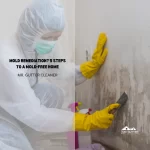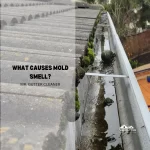Mold in homes arises from excess moisture and poor ventilation, leading to potential health risks and property damage.
Addressing this issue is crucial for maintaining a healthy living environment and preserving the integrity of one’s home.
Effective mold management involves understanding its causes, such as humidity or water leaks, and implementing preventative measures like improving air circulation and keeping areas dry.
Homeowners should regularly inspect their homes for signs of mold, identifying common areas like bathrooms, kitchens, and basements where it may thrive.
Removing mold promptly when detected, either through DIY methods for minor infestations or professional remediation for more severe cases, ensures the safety and well-being of residents.
Additionally, long-term strategies to prevent mold growth include using dehumidifiers, ensuring proper insulation, and maintaining clean, dry surfaces.
This approach not only addresses the immediate concerns related to mold but also contributes to the overall maintenance and value of the home.
What is Mold?
Mold is a fungus that grows in the form of multicellular filaments called hyphae. It proliferates in moist environments, making homes with water damage, high humidity, or inadequate ventilation ripe for mold development. Understanding mold is crucial for effective home maintenance and ensuring a healthy living environment.
What Causes Mold in Homes?
Mold in homes results from excess moisture that can arise from leaking pipes, roofs, windows, or areas with poor ventilation. High humidity levels, especially in areas like bathrooms, kitchens, and basements, also contribute to mold growth. Identifying and addressing these moisture sources is key to preventing mold.
Types of Mold and Their Identifiers
There are several types of mold, each with unique characteristics. Common household molds include Aspergillus, found on food and in air conditioning systems; Cladosporium, which prefers cool areas; and Stachybotrys, also known as black mold, which is particularly toxic and grows on water-damaged building materials. Recognizing these types can guide appropriate removal strategies.
Health Risks Associated with Mold Exposure
Exposure to mold can lead to health issues, ranging from allergies and respiratory problems to more severe reactions in individuals with asthma or compromised immune systems. Symptoms include coughing, sneezing, skin irritation, and eye irritation. Understanding these risks underscores the importance of prompt mold identification and remediation in maintaining indoor air quality and occupant health.
Preventing Mold Growth
Preventing mold growth is essential for maintaining a healthy home environment and protecting its structural integrity. Effective mold prevention hinges on controlling indoor humidity levels and ensuring adequate ventilation throughout the home. By addressing these key factors, homeowners can significantly reduce the risk of mold proliferation.
Essential Humidity and Ventilation Practices
Maintaining indoor humidity levels between 30% and 50% is crucial in deterring mold growth. Use of dehumidifiers and air conditioners during humid months, alongside ensuring proper ventilation in high-moisture areas like bathrooms and kitchens, helps maintain these optimal conditions. Regularly opening windows and using exhaust fans expels moist air, preventing condensation and mold.
Effective Water Leak Management
Water leaks are a primary contributor to mold development. Regular inspections of pipes, roofs, windows, and appliances for leaks and immediate repair of any detected issues are vital. Properly sealing windows and doors also prevents water ingress, further mitigating mold risk.
Regular Cleaning and Maintenance Tips
Routine cleaning and maintenance play a pivotal role in mold prevention. Surfaces prone to moisture, such as bathroom walls and kitchen counters, should be cleaned regularly with mold-inhibiting products. Ensuring gutters are clean and downspouts direct water away from the home’s foundation also reduces moisture accumulation that could lead to mold.
Identifying Mold in Your Home
Identifying mold promptly is crucial to preventing its spread and mitigating health risks. Homeowners can detect mold through visual inspection and awareness of musty odors, which often signify mold presence even before it becomes visibly apparent. Recognizing the common areas and conditions that foster mold growth is the first step towards effective mold management.
Common Areas Prone to Mold Growth
Mold commonly thrives in damp, humid areas of the home such as bathrooms, kitchens, basements, and around leaks in roofs, windows, or pipes. Areas with poor ventilation, where moist air becomes trapped, are also susceptible. Regularly inspecting these areas for signs of mold or moisture can prevent widespread mold growth.
Signs and Symptoms of Mold Presence
The presence of mold is indicated by visible growths, which may appear as spots or patches of various colors, and a musty, earthy odor. Physical symptoms in residents, such as allergies, respiratory issues, or skin irritation, can also suggest mold presence. Immediate action should be taken upon noticing these signs to identify and remove the mold source.
DIY Mold Removal Techniques
Removing mold yourself can be an effective way to handle minor infestations and prevent the spread of mold in your home. Safe and effective DIY methods can help you tackle mold problems without the immediate need for professional services. Understanding the right techniques and safety precautions is key to successful mold removal.
Safe Cleaning Solutions for Mold Removal
For non-porous surfaces, a mixture of water and detergent can be effective for cleaning mold. For tougher mold stains, a solution of bleach and water (1 cup of bleach to 1 gallon of water) can be used. Always wear protective gloves and ensure the area is well-ventilated when using bleach. Never mix bleach with ammonia or other cleaners, as it can produce dangerous fumes.
Step-by-Step Guide to Removing Mold
- Identify the mold-affected area and protect yourself with gloves, goggles, and a mask.
- Prepare the cleaning solution appropriate for the surface being treated.
- Apply the solution to the moldy surface and scrub with a stiff brush.
- Rinse the area with clean water and dry thoroughly to prevent mold from returning.
- Dispose of any moldy materials that cannot be cleaned (e.g., porous materials like drywall) in a sealed bag.
When to Use Professional Mold Removal Services
DIY mold removal is suitable for small areas (less than about 10 square feet). If the mold covers a larger area, is in the HVAC system, or if you have health concerns, it’s advisable to hire professional mold remediation services. Professionals have the equipment and expertise to safely and effectively remove extensive mold infestations.
Professional Mold Remediation
Professional mold remediation is essential when mold growth exceeds a manageable extent or when it poses health risks to the occupants. This process involves experts who assess the mold situation, contain the affected area, and systematically remove the mold using specialized equipment and techniques. Understanding when and how to employ professional services ensures effective mold resolution and prevents its recurrence.
How to Choose a Mold Remediation Service
Selecting a professional mold remediation service requires careful consideration. Look for certified professionals with experience in mold removal, preferably with references or positive reviews. Ensure they follow industry standards like those set by the Environmental Protection Agency (EPA) or the Institute of Inspection, Cleaning and Restoration Certification (IICRC). A reliable service will conduct a thorough inspection, provide a detailed plan for mold removal, and offer measures for preventing future mold growth.
What to Expect During Professional Mold Removal
The mold remediation process starts with a comprehensive assessment of the mold extent and its source. Professionals will then contain the area to prevent the spread of mold spores during removal. Using HEPA vacuums, antimicrobial treatments, and possibly removing mold-infested materials, they will eradicate the mold. Post-removal, they should verify the removal’s success and possibly suggest humidity control measures to prevent mold’s return.
Post-Removal Mold Prevention Strategies
After professional mold remediation, it’s crucial to implement strategies to prevent mold from returning. This includes fixing water leaks, improving home ventilation, controlling humidity levels, and regular inspections of potential mold hotspots. Some services offer waterproofing and sealing solutions as preventive measures against future mold problems.
Legal and Insurance Considerations
When dealing with mold in your home, understanding the legal and insurance aspects is critical. Mold can not only affect your health and home integrity but also have implications on your legal rights and insurance coverage. Navigating these considerations ensures protection against potential losses and liabilities associated with mold damage.
Understanding Your Rights as a Tenant or Homeowner
For homeowners, it’s important to address mold issues promptly to prevent property devaluation and maintain a safe living environment. Homeowner rights typically include seeking compensation or remediation services from builders, contractors, or previous owners if mold results from construction defects or undisclosed issues.
Mold and Home Insurance: What’s Covered?
Most home insurance policies cover mold damage if it’s a result of a “covered peril,” such as water damage from a burst pipe. However, mold resulting from neglected maintenance, such as ongoing leaks or high humidity levels, may not be covered. It’s crucial to review your policy details and communicate with your insurance provider to understand what mold-related damages are covered. Some insurers offer mold coverage as an add-on, which might be a wise investment in high-humidity areas or older homes prone to water damage.
Long-Term Mold Prevention
Long-term mold prevention is pivotal in maintaining a healthy, safe, and comfortable home environment. By implementing strategic improvements and regular maintenance, homeowners can significantly reduce the risk of mold recurrence, protecting their property and health over time.
Innovative Home Improvements for Mold Prevention
Investing in home improvements that enhance moisture control and air quality can drastically reduce the likelihood of mold growth. These improvements may include installing dehumidifiers in high-moisture areas, using mold-resistant paint and materials during renovations, improving home insulation to prevent condensation, and ensuring that the home’s design promotes adequate air circulation. Additionally, upgrading ventilation systems in bathrooms, kitchens, and laundry areas can expel humid air directly outside, preventing moisture accumulation.
Regular Home Inspections and Maintenance Schedules
Consistent home inspections are crucial for identifying potential mold issues before they escalate. Homeowners should schedule regular inspections of roofing, plumbing, and HVAC systems to ensure there are no leaks or condensation problems. Cleaning gutters and downspouts to prevent water buildup around the foundation and inspecting window seals and door frames for leaks can also prevent water ingress. Maintaining a regular cleaning schedule, especially in moisture-prone areas, and promptly addressing any signs of water damage or mold can prevent the conditions mold needs to grow.
Frequently Asked Questions About Mold
Homeowners often have numerous questions about mold, its impact, and how to deal with it effectively. Addressing these queries is crucial for maintaining a healthy living environment and ensuring the structural integrity of homes. This section aims to answer some of the most common questions related to mold in the context of home maintenance.
Can Mold Come Back After Removal?
Yes, mold can return after removal if the underlying issues of moisture and humidity are not resolved. Effective long-term prevention involves addressing leaks, ensuring proper ventilation, and maintaining optimal humidity levels to deter mold growth. Regular inspections can help identify potential mold sources before they become significant problems.
How Often Should I Inspect My Home for Mold?
It’s advisable to inspect your home for mold at least annually or as seasons change, especially in areas prone to high humidity. More frequent inspections should be considered if your home has experienced water damage or if you notice signs of humidity issues. Areas like basements, bathrooms, and kitchens, known for higher moisture levels, may require more attention.


